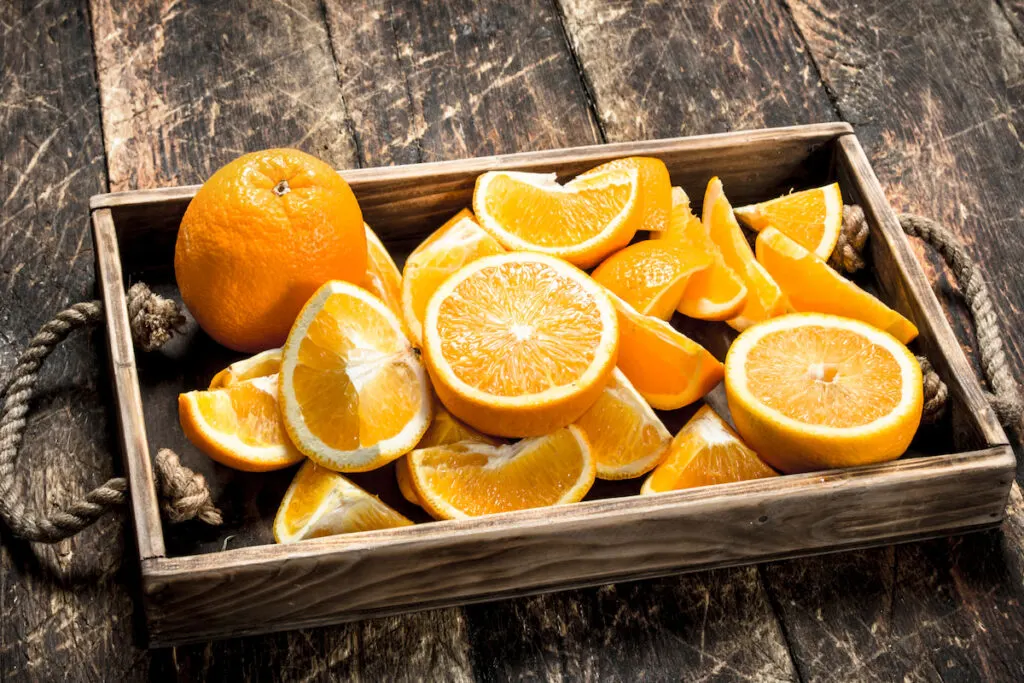Mealworms are known for their omnivorous nature. It’s common knowledge they are fans of practically everything – from veggies to table scraps. The only thing you should be careful about when feeding your mealworms is that the food is not contaminated by any dangerous pollutants.
Can mealworms eat oranges?
Mealworms can eat oranges but they should eat them only in moderation.
If oranges are fed too often, it could lead to unbalanced pH balances in the bin, discomfort, or even death of your mealworms.
Oranges are quite specific treats for mealworms, and knowing how to give them properly to not harm these little creatures will be valuable for you.

Table of Contents
Are Oranges Good for Mealworms?
Like any fruits and natural foods in general, oranges are full of vitamins and nutrients. And even though we don’t recommend treating your mealworms with oranges or other citruses often, they are still nutritious.
Today, worm farmers experiment with the foods they give to their little pets. Oranges, and citruses in general, are one of those products.
Generally, only advanced farmers know how to do it right, as it requires observation skills and practical knowledge of mealworm growing.
Why Can’t I Feed Oranges Freely?
We all know how tasty and juicy oranges are. What a satisfaction it is to chew sweet orange flesh with juice dripping on our hands. But what will happen if we try to feed mealworms, those little food destroyers, some orange? How bad can it be?
Oranges, just like other citruses – lemons, limes, grapefruit, pineapple, etc. – are great sources of citric acid, which is safe for humans, but can harm worm creatures if not controlled.

Mealworms, just like the rest of their crawling family, have specific physiology and are resistant to some foods and vulnerable to others. Their skin is an extremely important organ, as it allows mealworms to breathe, similar to how our human lungs work for us.
Unfortunately for mealworms, their breathing organ is the most sensitive and vulnerable one as skin is first in the line to contact the outside world. That’s why when citric acid from oranges comes in contact with their skin; it can irritate the breathing process, or even interrupt it!
In some cases, citric acid can lead to a fatal conclusion. The severity depends on the amount of acid in the fruit.
Mind the pH Level
Acidity is harmful not only for worms directly but also the environment they live in. As mealworms tend to live in restrained areas like bins, it is particularly important to mind what you put in their house.
If you are new to growing mealworms and lack certain knowledge, one thing to remember is to maintain a safe pH level in the bin.
In a well-maintained mealworm habitat, the pH level usually shifts between 6.0 and 7.0.
Citrus fruits, particularly oranges, have a pH of between 3.69 to 4.34, which makes this fruit quite acidic. That’s why giving mealworms oranges regularly will negatively affect the pH level in the bin, causing danger to its inhabitants.
In other words, citric acid will simply contaminate the worms’ bedding.
What Other Foods Should Be Restricted?

Aside from oranges and citruses in general, there are other foods you shouldn’t give mealworms if you want to keep them safe.
Spicy foods like chili pepper and onions are on the list of foods to avoid.
However, we bet you didn’t expect to see bread here, accompanied by pasta and cereal. They’re not completely banned, but should be given in small portions to prevent digestion problems.
The Importance of Moderate Feeding
Still, despite its risk to mealworms, you can feed them some oranges. Moderation is the key. However, if you’re a beginner, we don’t recommend you to include oranges and other risky foods into the mealworms’ diet.
But if you have some experience and confidence, you can try treating your mealworms with bits of orange. The best way to do so is to put pieces of orange on the remote corner of the bin so that worms can reach them if they want or stay away in case they feel discomfort. This applies to both flesh and peels.
However, don’t get encouraged too much. Even though feeding citrus is allowed; including oranges in a regular diet is not recommended for the reasons already mentioned.
The same is applied to other citrus fruits like lemons, grapefruits, or even pomelos.
Feeding pomelos to mealworms has its peculiarities. It’s not a good idea to put a piece of pomelo – flesh or peels – in the bin as it will take a lot of time for it to decompose, while also releasing citric acids. This is because they have thicker peels than other citrus fruits
To prevent this from happening, you can put pomelo in a container and keep it as long as it needs to decompose and lose most of its acids. Then, it’s safer for mealworms to eat it.
Another tip that’ll help you manage a delicate “orange issue” is adding extra bedding for the bin. Eggshells are really useful for such a task. They balance out the pH level in the bin, so it becomes more neutral and thus safer for worms. This way, you can start experimenting with citruses gradually.
The most important thing is to remember to only offer it in moderation.

Final Words
Growing mealworms is an exciting, but also a difficult job – especially if you’re new to it. But enthusiasm is always worth being praised.
We hope this article has helped you to find some answers and gain more confidence in this business.
Resources:
- https://www.solanacenter.org/news/blog-posts/composting-worms-dont-citrus-or-spicy-foods-heres-why
- http://www.foodwise.com.au/wp-content/uploads/2013/07/Worms-ONLINE-1.pdf
- https://thesquirmfirm.com/will-red-wiggler-worms-eat-stale-bread/
- https://kylonpowell.com/what-do-mealworms-eat/#23_Do_Mealworms_Eat_Oranges
- https://petkeen.com/what-do-mealworms-eat/
- https://catalog.extension.oregonstate.edu/sites/catalog/files/project/pdf/em9034.pdf
- https://wormmy.com/do-worms-eat-fruit/
